MiniatureBuildings.co.uk : Exploring model buildings of all sizes and styles
- Page (top)
- Home
-
About
Us -
Recent
Articles -
Scales &
Uses - Modelling
-
All
Articles
Miniature Buildings
(top of page)
Home
Articles
- Miniature
Buildings - Home +
-
Recent
Blogs -
All
Articles
.
Miniature Buildings
Some thoughts on building models of all types and sizes
Some thoughts on building models of all types and sizes
Welcome. If you have not visited Minature Buildings before can I suggest you begin with my Aims and Scope article or at the Home Page. If you have visited before - welcome back. I hope this article is of interest to you.
Terraced shops

The full size 'model' used for
Open All Hours
This article, even more than most, is firmly rooted in the United Kingdom. Except for a little postscript about Paris and New York! A familar sight in England, and I think elsewhere in the UK, is the Victorian or Edwardian terraced shop. Not necessarily in town centres these days but along the roads leading into the town centre, or in the inner suburbs of bigger cities.
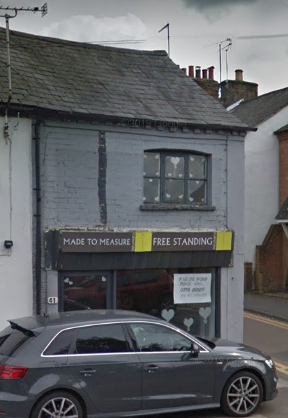


 Some local examples.
Some local examples.
Sometimes terraced, sometimes semi-detached.
Once occupied by small mainstream shops - grocers, butchers, bakers, greengrocers and drapers, they are now home to all sorts of second and third tier businesses. The ones near me included a convenience store, a tattoo parlour, a chinese takeaway, a computer repair shop and a pet store.
They are common in real life and they are a popular subject for 'lineside buildings' models in various mediums. In fact, searching for images of "terraced shops" on Google seems to give as many hits for models as for the real thing. Scalescenes, Metcalfe, 3DK and others all offer one or more.

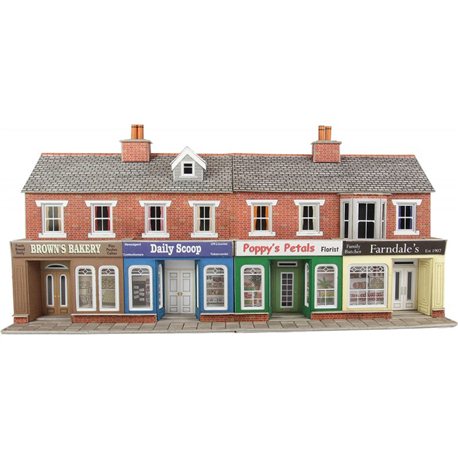
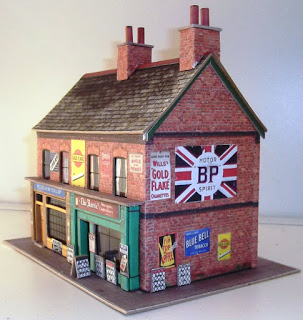
Examples from Scalescenes, Metcalfe & 3DK
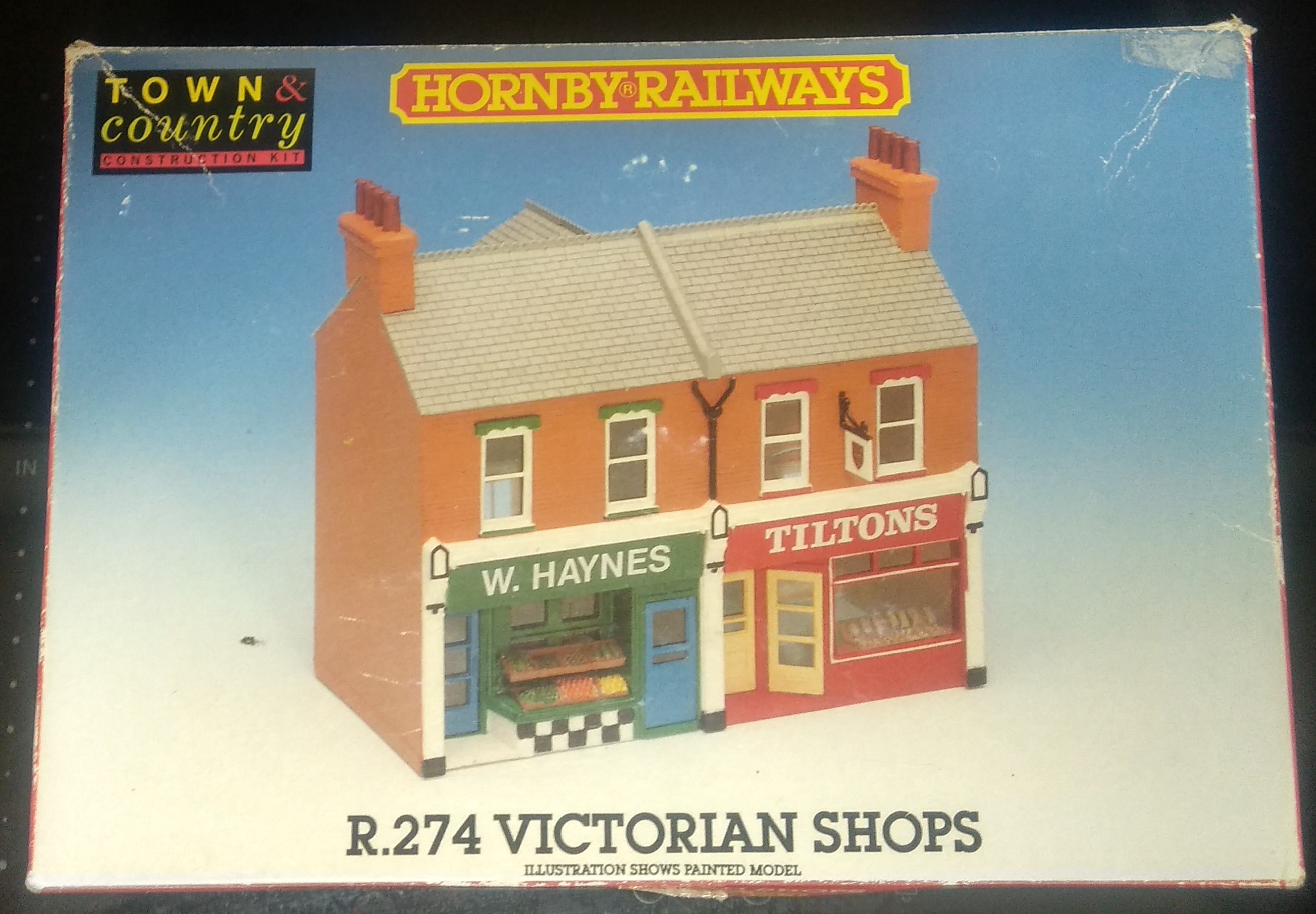
Indeed it was just such a model that prompted this article. A two week Covid quarantine seemed like a good time to have a go at a Hornby Town & Country model that had been sitting its box for many years. It seems (though I only started it - it still sits unfinished ) like a nicely made and well detailed plastic kit.

As seen on the box top
What I found rather off-putting was the chocolate-box artwork of what the finished product might look like. It felt unreal. I generally like my models rather grittier. The challenge facing me is to finish the kit in a better way.
Clear and detailed images of good prototypes seem quite hard to find.





General pictures of street scenes
exist but close -ups are rare

But two things are clear. Signage and windows are much fussier and more congested than the Hornby illustration. The shops are often scruffier. The colours tend to be darker, grubbier and more battered. Some of this is simply down to weathering - which is a subject all in its own right, discussed in another article.
But some of the difference is the basic selection of colours. Black, dark blue, a deep green-grey, or a dull maroon all seem to feature more than bright grass green or scarlet. As well as plenty of dirty faded shades of white. That's not to say that there are not some very garish shop fronts screaming at the buying public for attention.

But the neat, tidy, colourful, wholesome corner shop is something of a picture book illusion.
I'm not allowed to reproduce their high resolution professional photos but you may find it helpful to take a look at the Alamy page showing 1043 of their 'stock' images of 'Terraced Houses And Shops'. A very extreme example featuring black and shades of grey can be seen here. I would love to show it to you but Alamy want £29.99 for me to reproduce it on a website. They have a business to run but that sort of charge is unrealistic for a hobby blog such as mine that generates no income.

Prominent on many shop fronts is a distinctive pillar either side, with a moulding at the top. Sometimes fancy, sometimes very simple. If you are not already familar with this element take a look at a few parades of shops. I'm sure it will not be long before you find examples. It is a feature included in the Hornby injected moulded plastic kit.

But it is hard to reproduce in a card model. Which is one of the reasons why my instincts on forms of modelling are not purist. Printed images allow loads of detail that is hard to create and paint in and on wood or plastic. Yet card is not a great medium for fine 3D features. Take a look for example at the treatment of pillars on 3DK's interesting and detailed OO-8 shops model:

3DK of Scotland are new to me but say they have been operating for over 10 years. They offer a couple of free downloads which gives you a chance, like me, to check them out. At first glance they look very nice though I do have reservations about including downpipes on the printed sheet. I think that sort of detail is something the modeller really needs to add themselves with some three dimensional material. At the date of writing this (October 2022) they say a new range of low relief shopfronts are on their way. One of the photos on that page (which I hope they do not mind my reproducing below) reinforces my earlier comment about the muted colour palette and cluttered windows of many such shops.
I digress. What seems clear is that the pillar, the corbel moulding and the box along the top are very often (but not always, of course) painted in a single colour
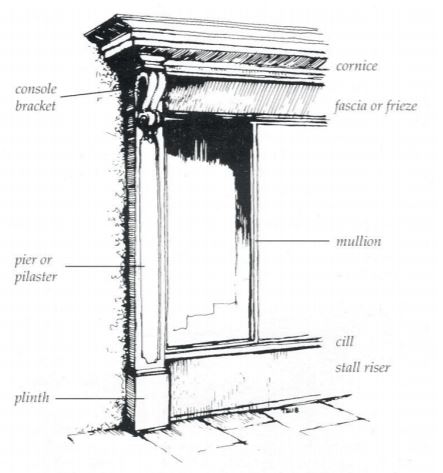
That pillar, and the moulding capping it, is discussed in a lot more detail in local authority planning guidance. This text comes from the East Lindsey district council site but I'm sure there are similar materials produced by other authorities. According to this guide to traditional shop front design "A shop front acts as a frame for the goods displayed and for the void in the front elevation of the building. Most 18th and 19th century shop fronts use a freely interpreted version of the Classical Orders for the main components of the frame - stall risers and cill at the bottom, pilasters and consoles at the sides, and cornice and fascia along the top."

I thought the moulding was called a corbel but console is apparently more accurate. According to Wikipedia "a corbel is a structural piece of stone, wood or metal jutting from a wall to carry a superincumbent weight, a type of bracket. A corbel is a solid piece of material in the wall, whereas a console is a piece applied to the structure."
Rather than just being a decorative cornice the top section in many cases, at least from the Victorian period, served an additional function. It was home to the shop blind. As can be seen in the following picture. Which also illustrates well how decorative the console can be

Illustrating the blind casing open and closed
For a detailed look at the shop blind I suggest you visit Ian Mansfield's blog posting Whatever happened to the traditional shop awning? Too much for me to summarise here. Am interesting and well illustrated article.
So, I must get back to my Hornby kit. I have chosen to make one of the shop fronts a dull dark blue (Humbrol 25 matt) and the other a dull brown. For the brickwork I am trying to recreate the dull yellow bricks known as London Stocks. My starting point was to use using Humbrol 187 matt ('Dark Stone') as a base coat. It looked promising but is I think a little too dark and to have a slight orange tint. My second attempt is with shade 121 'Pale Stone'. One day (for I'm not a quick worker!) I will post a photo of my finished product.
And my next project? Or yours? There are lots of interesting prototype shops out there that do not conform to the Open All Hours/Metcalfe/Hornby format. I should like to see something a bit different.

This lovely late 18th-century shopfront,
with its prominent bow windows, small panes
and narrow glazing bars, can be found just
south of Piccadilly Circus.
One modeller, whose work I much admire, is the creator of 'The Pickwick line'. Some of his shops break out from the regular terraced shops mould:
For lots more of the Pickwick line take a look at its Facebook page.
And finally....as far as England is concerned. Covid reminded us that the days of bricks and morter retailing may be coming to an end. And this iamge shows also how dirty London Stocks can get.
 A rather extreme example to stimulate
modellers way better than me.
A rather extreme example to stimulate
modellers way better than me.
And then, I discover nicolaspierreparis on Instagram. Who has a good line already on derelict shops. As well as many other lovely French models. I want to know more of this man. He defines himself as an artist and I think he has crossed that intangible line which I discuss a little more in my dioramas article.
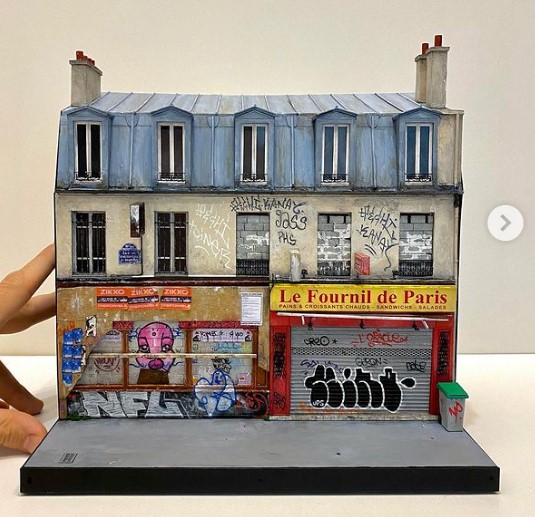 "Un immeuble situé à l'angle de la rue du Faubourg Saint-Martin et de la rue Lafayette... "
"Un immeuble situé à l'angle de la rue du Faubourg Saint-Martin et de la rue Lafayette... "
I promised a New York postscript. Take a look at the website of another artist, Randy Hage and his astonishingly detailed and lifelike 'sculptures' of disapearing New York shopfronts.
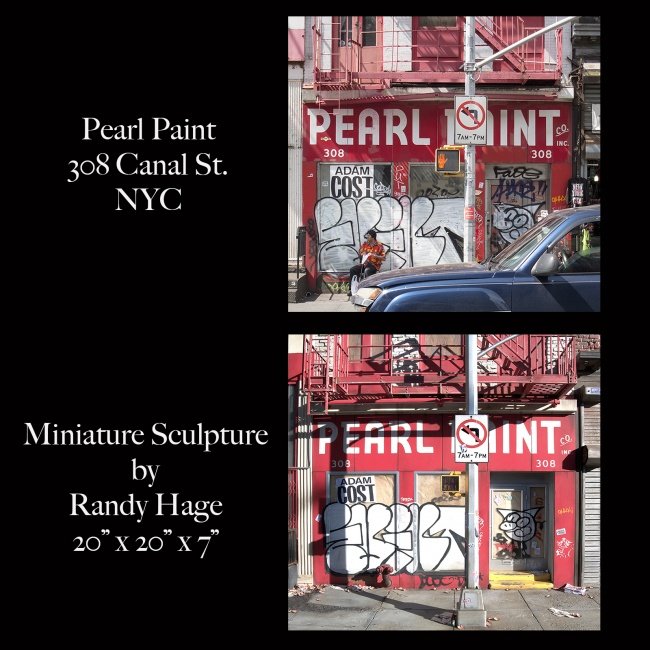
As seen on Randy's site,
with links to many more
As always, please
e-mail
Miniature Buildings
if you have something to add. Comments, criticisms,
extra thoughts, pictures, or even complete articles
for inclusion in the Miniature Buildings site
are all welcome. Or if you would like to be added to
my mailing list to hear when a new article is published.
David, December 2020
last updated October 2022